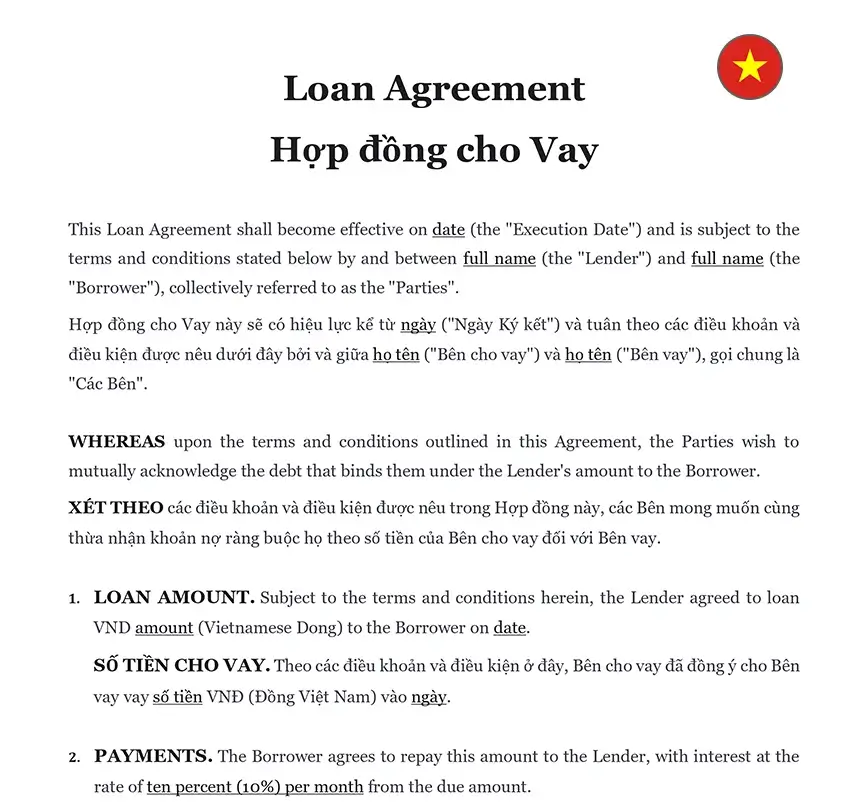Ready to use legal template
Drafted by experienced lawyers
Vietnamese-English translation
Ready to use legal template
Drafted by lawyers
Vietnamese-English translation
Home › Business contracts › Loan agreement
Learn more about Loan Agreement in Vietnam
A Loan Agreement is a legally binding contract that outlines the terms under which one individual lends money to another. It specifies key details such as loan amount, repayment terms, interest (if applicable), and penalties for non-payment, ensuring clarity and protecting both lender and borrower. In Vietnam, having a well-drafted Loan Agreement is crucial for personal loans between family members, friends, or business partners, as it helps prevent misunderstandings and disputes. This type of agreement is particularly important when lending significant sums of money, as verbal agreements may not be enforceable in case of disagreements. A properly structured Loan Agreement provides legal security and serves as proof of the transaction. Download our Loan Agreement, easy to edit in Word format, drafted by legal experts in both English and Vietnamese.
Table of contents
What is a Loan Agreement?
What is included in a Loan Agreement?
What is the purpose of a Loan Agreement in Vietnam?
Can a Loan Agreement be modified after signing in Vietnam?
Should I register a Loan Agreement with any government authority?
What happens if a borrower defaults on a Loan Agreement?
Are Loan Agreements enforceable in court in Vietnam?
Are there any tax implications associated with a Loan Agreement?
What is a Loan Agreement?
A Loan Agreement is a legally binding document that sets out the terms and conditions of a loan between a lender and a borrower. It typically includes details such as the loan amount, interest rate, repayment schedule, and any collateral that may be required. The agreement serves as a roadmap for the loan, outlining the rights and responsibilities of both parties. It helps to ensure that both the lender and the borrower are on the same page regarding the loan terms and reduces the risk of misunderstandings or disputes.
From a legal perspective, a Loan Agreement is essential as it provides a clear record of the loan transaction. It is a valuable tool for enforcing the terms of the loan in case of default or dispute. Additionally, a well-drafted Loan Agreement can help protect both parties’ interests by clearly outlining the terms of the loan and the consequences of non-compliance. Overall, a Loan Agreement is a crucial document that helps to formalize the loan process and protect the interests of both the lender and the borrower.
What is included in a Loan Agreement?
A Loan Agreement typically includes several key elements:
1. Loan Details:
This includes the principal loan amount, the interest rate, any fees, and the total repayment amount.
2. Repayment Terms:
This outlines the repayment schedule, including the frequency of payments (e.g., monthly, quarterly), the due dates, and the method of payment.
3. Interest:
The agreement specifies whether the interest is fixed or variable, and how it is calculated.
4. Collateral:
If the loan is secured, details of the collateral (e.g., property, equipment) are included.
5. Default:
This section outlines what constitutes default, the consequences of default (e.g., late fees, acceleration of the loan), and any grace periods.
6. Representations and Warranties:
Both parties may make certain promises or assurances regarding the loan, such as the borrower’s ability to repay.
7. Covenants:
These are obligations that the borrower must fulfill during the term of the loan, such as maintaining insurance or providing financial statements.
8. Events of Default:
This section outlines specific events that, if they occur, will be considered a default under the agreement.
These elements can vary depending on the specific nature of the loan and the parties involved.
What is the purpose of a Loan Agreement in Vietnam?
In Vietnam, a Loan Agreement serves several important purposes:
1. Legal Protection
It provides legal protection to both the lender and the borrower by clearly outlining the terms and conditions of the loan. This helps to prevent misunderstandings and disputes.
2. Enforceability
A Loan Agreement is a legally binding contract that can be enforced in court if either party fails to fulfill their obligations under the agreement.
3. Clarity
It ensures that both parties have a clear understanding of the terms of the loan, including the repayment schedule, interest rate, and any other relevant details.
4. Documentation
It serves as documentation of the loan transaction, providing a record of the agreement reached between the lender and the borrower.
- Remarks:
A Loan Agreement in Vietnam helps to protect the interests of both parties involved in the loan transaction and provides a legal framework for the loan.
Can a Loan Agreement be modified after signing in Vietnam?
In Vietnam, a Loan Agreement can be modified after signing, but only with the agreement of both parties. Any modifications to the agreement should be documented in writing and signed by both the lender and the borrower to ensure their legality and enforceability. It is crucial for both parties to clearly understand and agree to the modifications to avoid misunderstandings or disputes in the future.
The process of modifying a Loan Agreement in Vietnam typically involves drafting an amendment to the original agreement that outlines the changes being made. This document should include details such as the parties involved, the original terms of the agreement, the modifications being made, and the effective date of the changes. Once the amendment is signed by both parties, it becomes a legally binding part of the original Loan Agreement, reflecting the updated terms of the loan.
Should I register a Loan Agreement with any government authority?
In Vietnam, whether you need to register a Loan Agreement with a government authority depends on the specifics of the loan, such as the parties involved and the nature of the loan.
Private Loans Between Individuals: Typically, private loans between individuals do not need to be registered with any government authority. However, it is advisable to have the loan agreement notarized to enhance its enforceability in case of a dispute.
Commercial Loans: For commercial loans, especially those involving large sums or business entities, registration with relevant authorities might be required. This could include registration with the State Bank of Vietnam (SBV) if the loan involves foreign parties or certain types of transactions.
Foreign Loans: If a Vietnamese entity borrows from a foreign lender, the loan must be registered with the State Bank of Vietnam (SBV). This applies to loans with terms exceeding one year and certain short-term loans under specific conditions.
Real Estate-Related Loans: For loans secured by real estate, the mortgage agreement might need to be registered with the local land use rights registration office to be enforceable.
What happens if a borrower defaults on a Loan Agreement?
If a borrower defaults on a Loan Agreement in Vietnam, the lender has several options to enforce the terms of the agreement and recover the outstanding loan amount. These may include:
| ➤ Demand for Repayment: The lender can demand immediate repayment of the outstanding loan amount, including any accrued interest and fees, as per the terms of the Loan Agreement. |
| ➤ Legal Action: The lender can take legal action against the borrower to recover the outstanding debt. This may involve filing a lawsuit in a court of law and obtaining a judgment against the borrower. |
| ➤ Seizure of Collateral: If the loan is secured by collateral (such as property or equipment), the lender may have the right to seize the collateral and sell it to recover the outstanding debt. |
| ➤ Credit Bureau Reporting: The lender may report the default to credit bureaus, which could negatively impact the borrower's credit score and ability to borrow in the future. |
| ➤ Debt Collection Agency: The lender may engage a debt collection agency to recover the outstanding debt on their behalf. |




